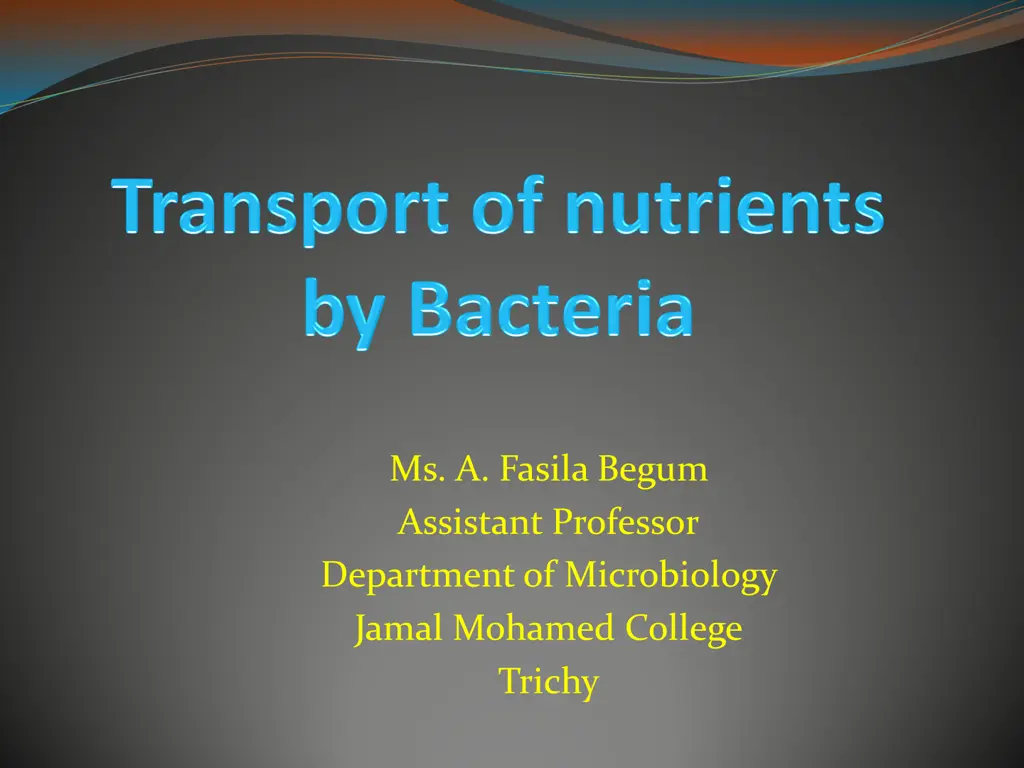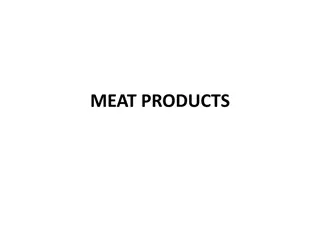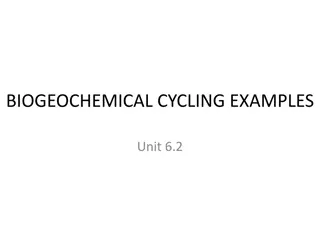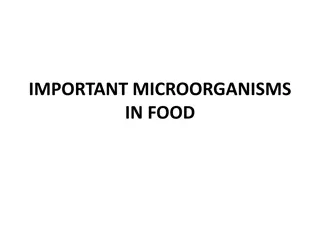Nutrient Uptake in Bacteria: Mechanisms and Factors
The process of nutrient uptake in bacteria, including the role of macronutrients, micronutrients, and environmental factors. Learn about the different mechanisms of nutrient transport and the importance of selective permeability in plasma membranes.
Download Presentation

Please find below an Image/Link to download the presentation.
The content on the website is provided AS IS for your information and personal use only. It may not be sold, licensed, or shared on other websites without obtaining consent from the author. Download presentation by click this link. If you encounter any issues during the download, it is possible that the publisher has removed the file from their server.
E N D
Presentation Transcript
Ms. A. Fasila Begum Assistant Professor Department of Microbiology Jamal Mohamed College Trichy
Introduction All microbes have a need for three things: carbon, energy, and electrons. Nutrients are substances in the environment used by organisms for catabolism and anabolism. Macronutrients Required in large amounts Carbon, oxygen, hydrogen, nitrogen, sulfur, phosphorus (components of carbohydrates, lipid, proteins and nucleic acids) Potassium, calcium, magnesium, and irons (cations and part of enzymes and cofactors)
Micronutrients microbes require very small amounts of other mineral elements (Trace elements) Irons, copper, molybdenum, and zinc Microbial growth conditions Macronutrients Micronutrients Growth factors Amino acids, vitamins, purines and pyrimidines Environmental factors Temperature, pH, oxygen
Uptake of nutrients Two problems to be considered during uptake of nutrients by bacteria. 1. Relative concentration Molecules and ions move spontaneously down their concentration gradient by diffusion. Molecules and ions can be moved against their Concentration gradient by active transport, but this requires the expenditure of energy (ATP)
2. Lipid bilayers are impermeable to most essential molecules and ions The lipid bilayer is permeable to water molecules and a few other small, unchanged, molecules like oxygen and carbon dioxide. These diffuse freely in and out of the cell. The diffusion of water through the plasma membrane is of such importance to the cell Osmosis.
Uptake of nutrients selectively permeable plasma membranes through passive diffusion and must be transported by one of three major mechanisms involving the use of membrane carrier proteins. Nutrient molecules frequently cannot cross Passive transport Active transport Group translocation
Passive Transport Passive transport is also known as simple or passive diffusion. Passive diffusion allows for the passage across the cell membrane of simple molecules and gases such as Carbon dioxide, oxygen and water. Passive transport is a movement of ions and other atomic or molecular substances across cell membranes without need of energy. The rate of passive transport depends on the permeability of the cell membrane.
In passive transport substances cross the membrane from an area of high concentration to area of low concentration without expenditure of energy. Three main kinds of passive transport Simple diffusion Facilitated diffusion Osmosis
Simple Diffusion Diffusion is the net movement of material from an area of high concentration to an area of lower concentration. Simple diffusion is the process by which molecules are moved along a concentration gradient in a solution or across a semipermeable membrane. Concentration gradient difference of concentration between the two areas.
Simple diffusion is carried out by the actions of hydrogen bonds forming between water molecules and solutes. The movement continues until the molecules are evenly distributed. The point of even distribution is called Equilibrium.
Facilitated Diffusion It is a form of facilitated transport involving the passive movement of molecules along their concentration gradient. Movement is guided by the presence of another molecule usually an integral membrane protein forming a pore or channel. Facilitated diffusion does not directly involve high energy molecules like ATP. The substance (glucose) to be transported combines with a carrier protein in the plasma membrane. (Permeases) Differ from simple diffusion in its use of carriers.
Osmosis The movement of water across a selectively permeable from a dilute solution (high concentration of water) to a more concentrated solution. Osmosis is when a substance crosses a semipermeable membrane order to balance the concentrations of another substance. Osmosis deals with solutions. A bacterial cell may be subjected to 3 kinds of osmotic solutions: Isotonic, Hypotonic and Hypertonic
Isotonic at both sides (in and out) of the membrane. In which over all concentration of solutes are same same rate. Water molecules leaves and enters the cell at the
Hypotonic solutes is lower than that inside the cell. Outside the cells medium whose concentration of solution they may burst as a result of excessive water intake which is known as plasmolysis. When a bacterial cells are placed in a hypotonic Hypertonic solute outside the cell than inside it. Most bacterial cell placed in a hypertonic solution shrunk and collapse because water leaves the cells by osmosis resulting in a cell shrinkage Opposite of a hypotonic solution. There is the more
Active transport Transport of molecules from an area of low concentration to area of high concentration. Against concentration gradient. In this process cell use energy (ATP) to move. Energy dependent transport of solutes from a lower concentration to high concentration via specific membrane bound carrier proteins. Active transport is most commonly accomplished by a transport protein that undergoes a change in shape when it binds with the cell s fuel, ATP.
For ex: one type of active transport channel in the cell membrane will bind to the molecule it is supposed to transport such as a sodium ion and hold onto it until a molecule of ATP comes along and binds to the protein. The energy stored in ATP then allows the channel to change shape, spitting the sodium ion out on the opposite side of the cell membrane.
Active transport depends on carrier protein in the plasma membrane. There are two types of Active transport Primary active transport Secondary active transport Primary active transport Use of chemical energy such as ATP, to drive the transport. Ex: ABC system which utilizes ATP binding Cassette Transporter. ABC transporter is composed of three different proteins.
i. Membrane spanning protein that form a pore across the cell membrane. ii. ATP binding region that hydrolyses ATP, provide energy for transport. iii. Substrate binding protein a peripheral protein that binds to the appropriate substance to be transported.
Secondary active transport It utilizes energy from Proton Motive Force (PMF). A PMF is an ion gradient that develops when the cell transport electrons during energy conserving process. Positively charged protons accumulate along outside of negatively charged cell, creating a proton gradient between the outside and inside of the cell.
There are three different types of simple transport Uniport Symport Antiport Each mechanism utilizes a different protein porters. Uniporters transport a single substance across the membrane (In or Out). Symporter transport two substances across the membrane at the same time.
Antiporter transport two substances across the membrane, but in opposite directions.
Group Translocation Distinctive type of active transport, using energy from an energy rich compound that is not ATP. The substance being transported is chemically modified in the process. By attaching a phosphte or co-enzyme A group to the substrate. Example for Group translocation is Phosphoenolpyruvate The sugar phospho transferase system (PTS) which uses energy from high energy molecule (PEP) to transport sugars in to the cell.
A phosphate transferred from the PEP to the incoming sugar during the process of transportation. In active transport, solute molecules move across a membrane without modification.
Many prokaryotes take up molecules by group translocation, a process in which a molecule is transported into the cell while being chemically altered. For example Phosphoenol pyruvate Sugar phospho transferase system (PTS). It transports a variety of sugars while phosphorylating them using phospho enol pyruvate as the donor. PEP + Sugar Pyruvate + Sugar P PTS s are widely distributed in prokaryotes.
Aerobic bacteria lacks PTS. Escherichia, Salmonella, Staphylococcus and other facultative anaerobic bacteria have phospho transferase system Some obligate anaerobic bacteria (Clostridium) also have phospho transferase system. Many carbohydrates are transported by these systems. E.coli takes up glucose, fructose, mannitol, sucrose, N- acetyl glucosamine, celloboise and other carbohydrates by group translocation.























